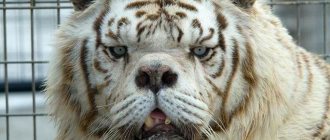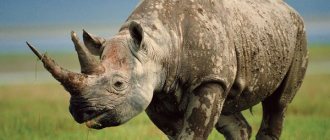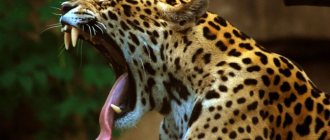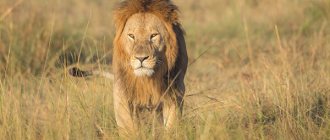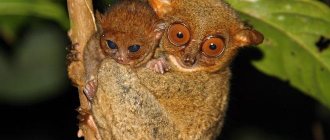Back in the century before last, these cats from the Panther family reigned over the lands of the Far East and adjacent territories of China. The Amur tiger is a unique animal adapted to life in cold climates.
For centuries, nature has created an ideal predator that survived in difficult conditions, but man quickly dealt with a large population of beautiful animals.
Ussuri tigers are on the verge of complete extinction and perhaps you would only see them like mammoths in pictures. In the middle of the last century, urgent measures were taken to preserve a sufficient number of individuals and restore the population of Far Eastern predators in the future.
Origin of the species and description
Photo: Amur tiger
The Amur tiger belongs to the class of mammals, the cat family. In terms of size and dimensions, it is considered one of the largest predatory animals, second only to the polar bear and brown bear. The weight of one individual can reach three hundred kilograms. According to official data, during the period when the animal was not on the verge of extinction, and there were quite a lot of populations, their weight reached 350-400 kilograms. At the moment, there are no more such representatives of this species left.
The physical strength and power of the game is amazing. It is capable of holding prey weighing half a ton, and dragging it for at least one and a half kilometers. Animals have the inherent ability to move at high speeds - up to 75-85 km/h.
Externally, Amur tigers are incredibly beautiful and graceful. The animal's skin has a red tint with black transverse stripes. In nature, no two tigers have the same pattern. Each member of this species has a unique stripe pattern. This color allows the predator to easily get lost in dense vegetation while hunting.
Video: Amur tiger
Most scientists and historians agree that eastern Asia was the homeland of predators. The history of the feline genus goes back about one and a half million years. In Siberia, Ussuri tigers did not appear relatively recently - no more than 15,000 - 18,000 years ago. The first remains of the ancient ancestor of the tiger were discovered in what is now China, on the island of Java. The remains of the ancestor belonged to the class Panthera Paleogenesis.
Compared to the current Ussuri tiger, it had a more modest size. Later, tiger populations spread to India, almost the entire territory of East Asia, as well as Siberia. In the 20th century, due to a sharp decline in the population, Siberian tigers were listed in the Red Book as a rare, endangered species.
Appearance and body structure features
Photo: Animal Amur tiger
The Amur tiger is considered one of the largest predators, as well as the largest of the wild cats. The average length of a male of this species is from 2 to 3 meters, excluding the tail. The tail length reaches 1-1.5 meters. Body weight is from two to three hundred kilograms. The maximum body length recorded among individuals of this species is 4 meters 20 centimeters, including the tail. Females are on average one meter smaller than males. Externally, Amur tigers look very graceful and flexible. The body is distinguished by developed, strong muscles. The animal reaches a height of just over a meter. The front part of the body is visually more massive, more developed and strong. The massive, strong forelimbs have five fingers, the hind limbs have four.
The tiger's head is quite large. Wide, massive forehead, wide cheekbones. The length of the skull is on average 15-20 centimeters. There are small round ears on the head. There are tanks on the side of the head on both sides. Long, white vibrissae arranged in five rows. Their length reaches 14-15.5 centimeters. Nature has endowed the Ussuri tigers with powerful, sharp jaws, in particular fangs. The length of the fang is 7.5-8 centimeters. The lateral surface of the tongue is equipped with tubercles that help the tiger wash itself and also separate the meat of its prey from the bone. Ussuri tigers have thick, tall fur, thanks to which they can easily withstand the peculiarities of the Siberian climate and strong winds.
The color of the tiger deserves special attention. The color of the coat and the location of the black transverse stripes differ among different populations, depending on the habitat. This is due to the fact that the main function performed by the animal’s skin is to provide camouflage.
On the muzzle in the area of the mustache, on the inner surface of the ears, chin and inner parts of the limbs, white color predominates. The predominant color of the coat on the body is red with transverse black stripes. In general, the number of bands does not exceed hundreds. The tail always ends in a black tip. On the tail, transverse stripes form rings. Most species have ten of them, less often a smaller number is found.
Where does the Amur tiger live?
Photo: Amur tiger from the Red Book
Before 1994-95, the tiger population was significantly larger. Their habitat was huge. They lived in Kazakhstan, in the northern part of Iran, India, and on the territory of the Sunda Islands. However, in the period from 1995 to 2006, this species was exterminated by almost half, and their habitat was significantly narrowed. Today, Amur tigers occupy only 6-7% of their original habitat.
It is noteworthy that each adult has its own habitat. On average, one female occupies 200-350 square kilometers, the male covers a larger territory, about one and a half thousand square kilometers.
To live in natural conditions, Amur tigers choose flat areas, river banks, valleys and forests. Predators also tend to live in mountain ranges reaching a height of 2000 meters above sea level. Tigers tolerate persistent, high frosts well. However, in such conditions they suffer due to lack of food and can come as close as possible to human settlements.
Geographical habitat areas of Amur tiger populations:
- territory of the southeast of Russia - Primorsky, Khabarovsk Territories, the coast of the Amur River, the Far East;
- People's Republic of China;
- Manchuria;
- India.
What does the Amur tiger eat?
Photo: Amur tiger in winter
The basis of the diet of predatory animals is meat. One adult Amur tiger eats from 8 to 20 kilograms of meat per day. A tiger can live no more than 3-3.5 weeks without food. The prey of the feline predator is mammals. On average, for normal life activities per year, one adult Amur tiger requires 50-50 heads of large herbivorous mammals. The spoils are:
- deer;
- roe deer;
- wapiti;
- wild boars;
- elk.
In the absence of large mammals, tigers hunt smaller animals. It could well be a hare, a badger, a gopher, a raccoon, a field mouse, some birds, a marmot, a fox, even a fish. Tigers hunt mainly in the dark. Predators have very acutely developed senses and vision. Thanks to the soft pads on their paws, they almost imperceptibly and silently approach the victim. They attack prey by jumping. The range of one jump of an Amur tiger reaches two tens of meters.
Predators most often drag their prey towards water sources. They always fight for her, driving her away and defending herself from others who want to profit. Predators eat lying down, holding their prey with huge, powerful front paws. If, as a result of the attack, the victim managed to escape, the Ussuri tiger stops the attack without making repeated attacks. He goes to rest. After regaining its strength, the predator again goes hunting in search of food.
Predators of the cat family have structural features of the larynx. Thanks to this, they are able to make sounds identical to those made by deer and roe deer during the mating season. In this way they attract ungulate mammals.
Tigers don't go hunting if they have food. They live in places as far away from human settlements as possible. Hunger and lack of food for a long period of time pushes one to approach a person. In extreme cases, they attack livestock and dogs.
Relationship with a person
The Amur tiger enters populated areas only in cases of extreme hunger in order to search for food; as a rule, its prey becomes domestic animals or dogs. Even in these cases, the animal tries to avoid meeting a person and rarely attacks him.
As a rule, the reason for an attack on a person is either a hunt for a tiger or a clash in a populated area when the animal is forced to defend itself.
Compared to other subspecies, this one is more peaceful towards people.
Features of character and lifestyle
Photo: Amur tiger animal
Huge representatives of the cat family are well oriented in the area. They move freely through the snow cover and are able to cover long distances. An adult travels about 40-50 kilometers per day. Amur tigers move mainly along the same routes. Change the trajectory of movement in the absence of prey. Games swim well and are able to overcome bodies of water several thousand meters long.
Predators divide the territory into squares. Each adult representative carefully protects its territory from competitors. When they appear, adult males rarely attack each other. They demonstrate their strength and power through their roars. The weaker one leaves on his own. Each representative marks its territory with urine in large quantities. Along the perimeter of the trees, the bark on the trees is torn off. To do this, he rises on his hind legs.
Males lead a separate lifestyle. Females can sometimes form small flocks. They are polygamous by nature.
The breeding season of the species occurs at the end of winter. After 3.5-4 months, kittens are born. Each female is capable of giving birth to up to four blind babies. Only the female participates in raising the babies. Males do not train or feed the brood. At the age of two months, she begins to feed the babies meat. After another 3-4 weeks, he gradually begins to teach hunting tactics. Tiger cubs lead an independent lifestyle starting from the age of two.
By nature, Siberian tigers are considered calm, noble animals. It is unusual for them to create unnecessary noise, conflicts, and fights. Attacking other members of its own species is an extremely rare occurrence. They are able to live in complete silence for up to several years. They share some of the habits of domestic cats. They love to play, purr, and cuddle. When an animal is angry, it growls, making a muffled, hoarse sound. When the tiger arrives in a rage, a so-called “cough” can be heard.
The average lifespan of one individual is 13-15 years. It has been proven that the animal can live up to fifty years. In most cases, they die much earlier.
Lifestyle
Tigers greet each other with special sounds produced by vigorously exhaling air through the nose and mouth. Signs of expression of friendliness are also touching heads, muzzles and even rubbing sides. The Amur tiger is the ruler of vast territories, the area of which in the female is 300-500 km². If there is enough food within its territory, the tiger does not leave its territory. With a shortage of game, the number of cases of tigers attacking large livestock and dogs increases. The Amur tiger is active at night. The female, like the male, marks her territory with urine or scratches on the bark of trees. Moving around its domain, the tiger constantly monitors its own marks and the signs of other tigers. Scent marks play a role not only in marking the hunting territory, they also ensure that animals of both sexes meet during the rut. The territories of males and females can overlap, since males defend their territories only from other males, paying special attention to the main border points. Males lead a solitary life, while females are often found in groups.
Social structure and reproduction
Photo: Amur tiger cub
Individuals of Ussuri tigers lead an isolated lifestyle. Males rarely join the pack. The habitat of individual individuals practically does not overlap. Due to its polygamous nature, a male can exist in one territory with several females at once. He enters into marital relations in turn with each representative of the opposite sex. Offspring appear most often once a year, three to four months after entering into mating relations. There are known cases of breeding offspring twice a year.
Females never abandon their young. Caring for the offspring falls entirely on the shoulders of the mother. The female obtains food for both herself and the cubs. She protects the kids, teaches them to hunt and lead an isolated lifestyle. If another male claims to enter into mating relations with one of the females, a severe attack cannot be avoided. Males fiercely defend their right and primacy to enter into mating relations. During the breeding season, females typically produce certain sounds with which they attract individuals of the opposite sex. Males rarely make any sounds during the mating season.
Puberty occurs upon reaching 4-5 years of age. Females also tend to mark their territory during the mating season. A week after the start of estrus, the female is ready for mating. Often tigresses themselves go in search of suitable partners. Often a sign that females are in search of a partner are marks on tree trunks.
On average, each tigress gives birth to two cubs. The survival rate of babies is extremely low. According to statistics, half of all born cubs die during the first months of life.
On the ninth day after birth, the babies' eyes open. After two weeks, teeth begin to appear. Despite the fact that the mother begins to feed the kittens meat from the age of two months, they continue to feed on mother’s milk for up to six months. Independent hunting is possible no earlier than from the age of one. An adult is considered an individual that has reached 3-4 years of age.
Natural enemies of the Amur tiger
Photo: Amur tiger Red Book of Russia
Despite the fact that the predator is a powerful, strong and fast animal, it remains absolutely defenseless against modern types of weapons. In East Asia, the animal's fur, bones and fangs are highly valued. Big money contributes to an increase in the number of poachers.
In addition to expensive and sought-after trophies, Amur tigers were shot for the purpose of producing medicinal products. Many derivatives have been used on a large scale in traditional oriental medicine.
In its natural habitat, the Amur tiger has no enemies. Almost no animal can handle it. He has no equal in strength and endurance. He is capable of defeating even an adult bear. The only enemy of the graceful handsome man is man.
Coat of arms of the Irkutsk region
As you know, the Irkutsk fort, founded in 1661, received the status of a city within 25 years. And after another 4 years he had his own coat of arms. In the chronicle of Pezhemsky and Krotov (Irkutsk, 1911) it is noted: “The coat of arms of Irkutsk was originally granted the highest in 1690. It represents a babr in a silver field, running through green grass and having a sable in its jaws...” The babr became the symbol of the city - the most beautiful and powerful a beast that lived at that time in the eastern outskirts of Russia and personified the power and greatness of Eastern Siberia. In the book by N. Speransov “Land coats of arms of Russia XII-XIX centuries.” we read: “Russian people who settled in Eastern Siberia and the Far East met for the first time with a tiger hitherto unknown to them. The strong and beautiful beast made a great impression on them... In Siberia the name (tiger) did not take root..., the beast received a new name from the Russians who lived in this region - Babr.” The second image of the coat of arms appeared in 1878, when Russian symbols were being streamlined in accordance with heraldic rules.
The King of Arms Baron Kene proposed a new type of decoration - a frame in the form of crowns, leaves and ribbons. And it was then that the tiger disappeared from the coat of arms. According to Alexander Sukhodolov, apparently, the capital’s officials, having encountered the incomprehensible word “babr”, decided to correct the mistake and wrote “beaver”. And at the same time the drawing was replaced: instead of the babr-tiger, an image of a chimerical animal with terrifying claws, blood-red eyes and a scaly tail appeared, running from right to left. A paradoxical situation arose when two coats of arms existed in parallel: the city coat of arms - babr and the provincial coat of arms - beaver. This is confirmed by the official publication of Winkler (1900). During the visit of the heir to Tsarevich Nikolai Alexandrovich to Irkutsk, a black image of an officially approved beaver appeared in the Irkutsk Provincial Gazette newspaper. “It must be said that the townspeople did not accept the new provincial symbol,” notes A.P. Sukhodolov, - it was very unusual for a Siberian resident that a swamp rodent was holding a handsome sable in its teeth. It seemed that he was not giving it to Russia, but strangling it.”
Later, in 1908, when a monument to Alexander III (installed on the Angara embankment) was designed in honor of the construction of the Trans-Siberian Railway in St. Petersburg, an erroneous symbol was again placed on one of the corners of the pedestal - something between a river beaver, a lion and a panther.
In the Soviet years there was no time for symbolism. The city emblem was remembered only in the early 1960s, when the 300th anniversary of Irkutsk was celebrated. Once again there was confusion. The image of the coat of arms was taken from the “Provincial Gazette” and, without going into historical details, they called the animal babr. Only a little later, Professor F.A. Kudryavtsev drew attention to the fact that the actual image of the Irkutsk coat of arms is not a black chimera, but a babr from the tiger family. But party censorship in the person of Oblitt worked clearly in those years. The erroneous image (for the second time in the city's history) became official.
Population and species status
Photo: Amur tiger in nature
The real hunt for the Siberian tiger began in the 20th century. On average, more than a hundred individuals of the Ussuri tiger were destroyed per year. It was during this period that the species practically disappeared. He could occasionally be found in the remote taiga, where it is almost impossible for a person to reach. Poachers on a huge scale shot graceful, handsome animals and captured tiger cubs. In the 40s, the number of individuals in the world did not exceed four dozen. Due to such a sharp decline in numbers, the species was listed in the Red Book.
The main reasons for the decline in the number of the species:
- increase in the number of poachers;
- climate change, winters with little snow;
- lack of food for predatory animals;
- destruction of predator habitats, destruction of flora and fauna.
Forest fires, destruction of forests, and the harmful effects of human waste products on the natural environment lead to a reduction in ungulate herbivores. All these factors reduce the habitat of predators. After a sharp decline in the number of individuals throughout the world, the Amur tiger was seriously threatened with complete extinction. However, people were able to take measures to prevent an irreparable natural phenomenon.
Taxonomy
Russian name - Amur tiger, Ussuri, Siberian, Manchurian English name - Siberian tiger Latin name - Panthera tigris altaica Order - carnivores (Carnivora) Family - felines (Felidae) Genus - large cats (Panthera) Species - tiger (Panthera tigris) Selected 9 tiger subspecies, of which only 6 had survived by the beginning of the 21st century. The Amur tiger (Pantera tigris altaica) numbers about 500 individuals in the wild. Bengal tiger (Pantera tigris) - about 4000 individuals. Indochinese tiger (Pantera tigris corbetti) - approximately 1,500 individuals. The Malayan tiger (Pantera tigris jacksoni) is found exclusively in the southern part of the Malay Peninsula - about 800 individuals. The Sumatran tiger (Pantera tigris sumatrae) is found only on the island. Sumatra, the smallest of the subspecies - 400–500 animals. The Chinese tiger (Pantera tigris amojensis) has disappeared from the wild; there are 59 tigers in captivity, but they are all descendants of six animals. The last Bali tiger was killed on September 27, 1937, the Transcaucasian tiger was last seen in 1968, and the Javan tiger in 1979.
